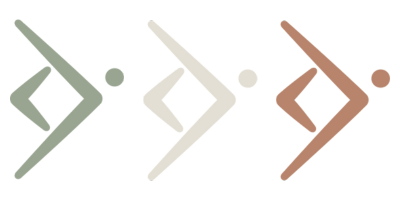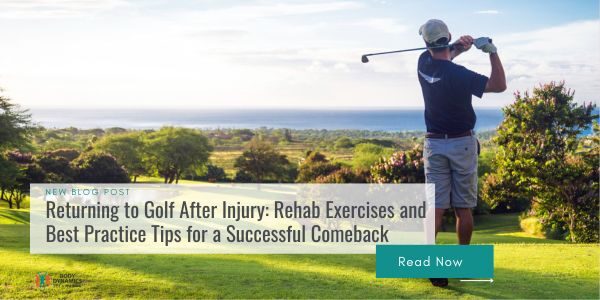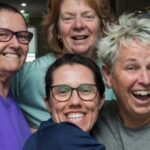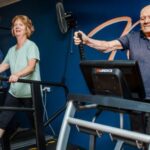If you’ve experienced a golf-related injury, it can be tempting to skip over the necessary rehabilitation. But returning to golf before you’re ready will likely only result in further exacerbation. The last thing you want is to forgo your rehab, experience on-going pain and deterioration of your golf action resulting in frustration and reduced enjoyment.
Proper rehabilitation for golf-related injuries is crucial because it aids in the healing process, strengthens the injured area and reduces long-term pain. Rehabilitation also helps in the recovery of mobility and muscle or joint function needed to play at your best, making it easier to return to golf after injury without doing yourself more harm.
COMMON GOLF-RELATED INJURIES
Most common golf-related injuries are generally caused by poor technique, a lack of strength, mobility and conditioning or excessive repetition of the swing motion. Though golfers may harm themselves in many ways, golf-related injuries most frequently impact the elbows, rotator cuff (shoulders), lower back and knees.
Elbow Injuries
Golfer’s Elbow is one of the most common golf-related injuries. It generally stems from an overuse of the forearm flexors, specifically impacting the tendons on the inner side of the joint. This golf-related injury causes pain and discomfort in the elbow and forearm, as well as weakness in the forearm and wrist.
Another similar golf-related injury is Tennis Elbow. Many people are often surprised to learn that this condition doesn’t just affect tennis players. Tennis Elbow has similar symptoms to Golfer’s Elbow, but the injury instead occurs on the outside of the joint. The symptoms associated with both Tennis Elbow and Golfer’s Elbow can make your swing fairly painful, forcing you off the golf course. Both of these injuries are classed as tendinopathies, which if not rehabilitated and managed correctly are often extremely persistent, impacting not only golf but many activities of daily living.
Rotator Cuff Injuries
Another very common site of golf-related injury is the rotator cuff. Injuries in this area, Rotator Cuff Tendinopathy and/or tears, for example, often result from poor technique and the repetitive movement of the golf swing. If inadequately rehabilitated, rotator cuff injuries can severely inhibit mobility both on the golf course and off it.
Lower Back Injuries
Lower back injuries are a very common golf-related injury. Lower back injuries typically fall into one of these three categories:
- Lumbar strains, also referred to as non-specific lower back pain, are “myofascial injuries” that involve tight and damaged muscles.
- Disc herniations are where the internal soft material of the disc between the vertebrae can push out into the harder exterior material, it is worth noting that golf may not cause a herniation, yet may irritate a disc that is already herniated.
- Exacerbated (facet) arthritis, also known as spondylosis, occurs when the cartilage in the spine deteriorates over time, leading to osteoarthritis. The golf action may irritate the arthritis and hence results in discomfort.
Knee Injuries
The twisting and pivoting movements involved in your golf swing can also cause patellar tendinopathy or meniscus tears. Patellar tendinopathy involves swelling and irritation of the patellar tendon, which connects your knee to your shin. This condition is often associated with severe pain when walking.
Meniscus tears damage the cartilage of your knees. When this golf-related injury happens, you might hear a pop, but you may not feel immediate pain. But be careful; though you may be able to play on immediately, your knee will swell and stiffen and occasionally lock over the next couple of days. This will reduce your mobility and increase your pain significantly.
TIPS FOR A SAFE RETURN
Returning to golf after injury shouldn’t happen all at once. It’s a process that involves a number of important steps best taken gradually to avoid re-injury.
- Consult a healthcare professional: Speaking with a healthcare professional, like your GP or an exercise physiologist, can help you know when it’s the right time to return to golf after injury. This is especially important after more severe golf-related injuries.
- Follow your rehabilitation plan: There’s no magic formula to healing. It’s all about putting in the effort and sticking with your rehabilitation plan over the prescribed period of time.
- Start slowly: When you start golfing again, you may not initially be able to practice as frequently as you once did. It’s best to start with shorter rounds and gradually increase the duration and intensity as your injury finishes healing and your confidence grows.
INJURY MAINTENANCE AND PREVENTION
To avoid further golf-related injuries or re-injury, you need to have an injury-prevention plan in place. Though these plans may differ from person to person, they generally have a few things in common:
- Warm-up thoroughly: Before you get swinging, you should perform a warm-up routine that focuses on stretching and loosening the muscles and joints involved in your swing.
- Train your muscles: Strengthening the muscles around your injury, or any other muscles prone to overuse in golf, can help prevent injuries (or re-injury) before they happen.
- Listen to your body: Your health is more important than your next swing. If you feel any niggling pains coming on, avoid pushing yourself and give your body the rest it needs.
- Consider supportive gear: Braces or wraps can support and reinforce your bones, muscles and joints and prevent making any old injuries worse.
Get back into golf with confidence
If you’re serious about returning to golf after injury, we recommend seeking professional help from a trained exercise physiologist, like us at Body Dynamics Illawarra. Our Beginner Golf Program is the perfect place to get started if you are looking to get into golf for the first time and are currently active, looking to prevent preventable injuries from golf or you have worked through your rehab program and are looking for a bit more to compliment your return to golf.










